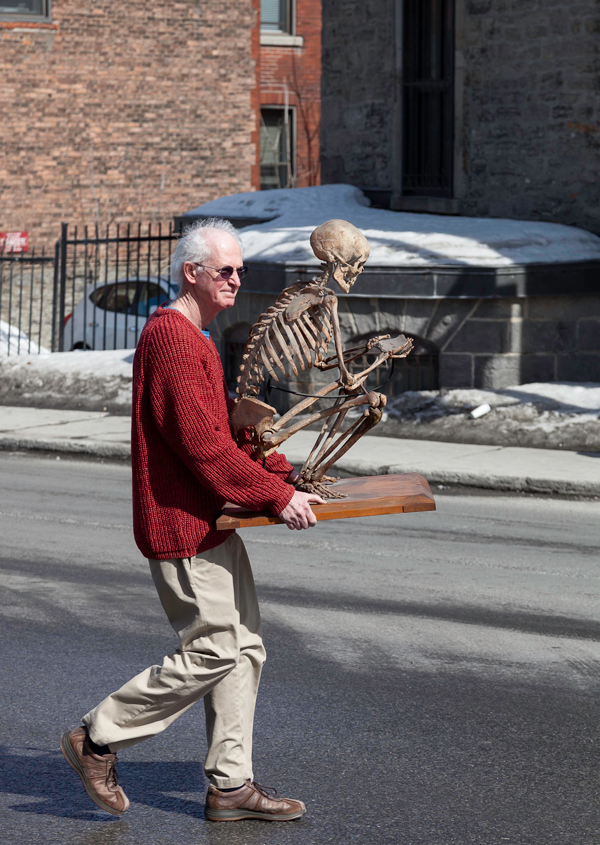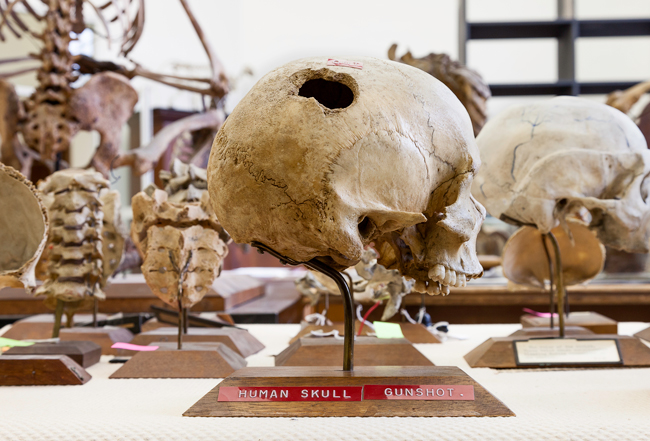
Unique medical history collection gets new digs
By Neale McDevitt
People standing on the corner of Pine Avenue and University at the end of March would have been excused if they thought Halloween was coming early to McGill, as full skeletons were being transported by hand from the Duff Medical Building to the Strathcona Anatomy and Dentistry Building.
With the Pathology Department transferring from the Duff to the Glen site, it followed suit that the Maude Abbott Medical Museum – a unique collection of materials dating from the early 19th century that documents the study and practice of Medicine at McGill and its associated teaching hospitals – would also be relocated.
“We moved all of our fluid-based material last year and it was a huge job, that we did ourselves,” says Dr. Richard Fraser, a pathologist at the MUHC, a professor of pathology in the Faculty of Medicine, and the Museum’s director. “There were about 2,000 specimens in glass containers containing fluid so some of them were fairly small but others were very large and very heavy.”
The remaining 1,000 dry specimens were moved at the end of March and while movers were used this time relocate the remaining 1,000 dry specimens a few weeks ago
The dry specimens include everything from vintage anatomical wax models from the late 1800s, to a collection of some 75 bones from the American Civil War – complete with gruesome bullet wounds.
And speaking of gruesome bullet wounds, a funny thing happened when Fraser and his colleagues were packing up the dry specimens for the move – they discovered a number of items that had been tucked away in cupboards or on shelves, including a human skull sporting a two large bullet holes. The proverbial skeleton in the closet – with a difference.

“It is a scary specimen, with a rather impressive entry and exit wound. I’m not sure what caliber of bullet it was but clearly large enough to kill this individual,” says Frazer. “I’ve been working at the Museum for some 15 years now and I thought I had seen the entire collection, but this was definitely a surprise.”
But while the cause death of this unfortunate individual is fairly obvious, the details surrounding their life are considerably less evident. “We know that the skull was donated by the Army Medical Museum and all of the Civil War material came from them as well,” says Fraser. “For sure, the skull is pre-1900, so it is conceivable that it is from that collection but we don’t have its full history just yet. We need to look into it further.”
The skull isn’t the only Museum specimen shrouded in mystery.
One skeleton, mounted in a crouching position (see top picture), was donated to the Museum by Sir Auckland Campbell Geddes in the early 1900s.
The skeleton was said to have been found on the east coast of England and was supposed to be a specimen of Paleolithic man. “Clearly, it is not a Paleolithic man but we’re not sure who it is or where it comes from. All we know is that it dates from the mid-1910s,” says Fraser. “This year, we hope to get some anthropology students to do some research on its origins.”
Another skeleton in the collection was a patient at the Royal Victoria Hospital in the 1930s who succumbed to Paget’s disease. “At that time, if a patient died in a hospital and no family member claimed the body, the remains basically belonged to the institution. Often they’d be used for educational purposes,” says Fraser.
“It is the kind of thing that would never be done now for a variety of reasons both practical and ethical,” he continues, “but it has great value as historical is specimen because it is one of the last of its kind where the whole body is preserved.”
Fraser says that the majority of the Museum’s inventory was acquired from Montreal hospitals and research centres under similar circumstances – including a collection of diseased hearts that doctors had sent to Maude Abbott for the renowned pathologist to study.
Fraser says that while much of the value of Museum’s vast collection is historical, more and more people are recognizing it for its original purpose as an educational tool.
“Last fall, for example, we mounted an exhibit in the second floor rotunda of the Strathcona Building on developmental anomalies such as heart defects and various other things,” says Fraser. “It’s being used as part of the embryology teaching for medical students.
“Also part of the material that is being used by two art history students for their exhibition of skin disease and art [3rd floor, Osler Library of the History of Medicine] is from our collection,” says Fraser. “So you can see, the collection is moving a little away from study and into exhibition. It’s a crossover between the two.”
While the Museum isn’t open to the public, groups can make reservations to take a tour of the collection. Recently, a West Island women’s group took the tour, as did a group of McGill employees during a Lunch and Learn session. Cardiology residents from the MUHC are set to view the collection in coming weeks. “Yes, the collection is interesting on a historical basis, but these cardiology students would not have the chance to see some of this material in the flesh, so to speak, except in a beating heart because you don’t see these specimens anymore,” says Fraser.
The goal is to get more students involved in the collection. For example, a group of Med 1 students are currently studying the anatomy of bones using specimens from the Museum. “At the same time that they are learning about normal skeletal anatomy, they are also developing an exhibit,” says Fraser.
Fraser’s long-term plan is to build a permanent display space for the collection – not an easy trick to pull in these financially austere times. The result, he says, would be nothing short of spectacular. “Clearly, I’m biased, but this collection could become one of the jewels of the University,” says Fraser. “Having visited some other museums around North America and England, I know that we have something that is first class. It’s certainly worth preserving both for its own sake but also because the intellectual value it has for the University and the meaning it has for the history of medicine here at McGill and also for its potential use in teaching.”
Read more McGill Reporter articles about the Maude Abbott Medical Museum
Remains of American Civil War soldiers live in storage…for now (May 2011)
